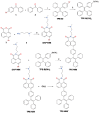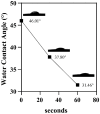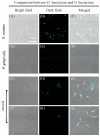Antibacterial and Fluorescence Staining Properties of an Innovative GTR Membrane Containing 45S5BGs and AIE Molecules In Vitro
- PMID: 35214970
- PMCID: PMC8874606
- DOI: 10.3390/nano12040641
Antibacterial and Fluorescence Staining Properties of an Innovative GTR Membrane Containing 45S5BGs and AIE Molecules In Vitro
Abstract
This study aimed to add two functional components-antibacterial 45S5BGs particles and AIE nanoparticles (TPE-NIM+) with bioprobe characteristics-to the guided tissue regeneration (GTR) membrane, to optimize the performance. The PLGA/BG/TPE-NIM+ membrane was synthesized. The static water contact angle, morphologies, and surface element analysis of the membrane were then characterized. In vitro biocompatibility was tested with MC3T3-E1 cells using CCK-8 assay, and antibacterial property was evaluated with Streptococcus mutans and Porphyromonas gingivalis by the LIVE/DEAD bacterial staining and dilution plating procedure. The fluorescence staining of bacteria was observed by Laser Scanning Confocal Microscope. The results showed that the average water contact angle was 46°. In the cytotoxicity test, except for the positive control group, there was no significant difference among the groups (p > 0.05). The antibacterial effect in the PLGA/BG/TPE-NIM+ group was significantly (p < 0.01), while the sterilization rate was 99.99%, better than that in the PLGA/BG group (98.62%) (p < 0.01). Confocal images showed that the membrane efficiently distinguished G+ bacteria from G- bacteria. This study demonstrated that the PLGA/BG/TPE-NIM+ membrane showed good biocompatibility, efficient sterilization performance, and surface mineralization ability and could be used to detect pathogens in a simple, fast, and wash-free protocol.
Keywords: aggregation-induced emission nanoparticles; antibacterial; antibacterial differentiation; bioactive glass; bioprobe; guided tissue regeneration (GTR).
Conflict of interest statement
The authors declare no conflict of interest. The funders had no role in the design of the study; in the collection, analyses, or interpretation of data; in the writing of the manuscript; or in the decision to publish the results.
Figures














Similar articles
-
Evaluation of the Antibacterial Effect of Silver Nanoparticles on Guided Tissue Regeneration Membrane Colonization--An in Vitro Study.J Int Acad Periodontol. 2015 Jul;17(3):66-76. J Int Acad Periodontol. 2015. PMID: 26373223
-
Naphthalimide-based multifunctional AIEgens: Selective, fast, and wash-free fluorescence tracking and identification of Gram-positive bacteria.Anal Chim Acta. 2021 Feb 15;1146:41-52. doi: 10.1016/j.aca.2020.12.037. Epub 2020 Dec 21. Anal Chim Acta. 2021. PMID: 33461718
-
Tri-layered functionally graded membrane for potential application in periodontal regeneration.Mater Sci Eng C Mater Biol Appl. 2019 Oct;103:109812. doi: 10.1016/j.msec.2019.109812. Epub 2019 May 28. Mater Sci Eng C Mater Biol Appl. 2019. PMID: 31349482
-
Photostable AIE probes for wash-free, ultrafast, and high-quality plasma membrane staining.J Mater Chem B. 2021 Jun 3;9(21):4303-4308. doi: 10.1039/d1tb00049g. J Mater Chem B. 2021. PMID: 33908594
-
Development of fish collagen/bioactive glass/chitosan composite nanofibers as a GTR/GBR membrane for inducing periodontal tissue regeneration.Biomed Mater. 2017 Sep 13;12(5):055004. doi: 10.1088/1748-605X/aa7b55. Biomed Mater. 2017. PMID: 28902637
Cited by
-
Research on the Antibacterial Properties of MXene-Based 2D-2D Composite Materials Membrane.Nanomaterials (Basel). 2023 Jul 20;13(14):2121. doi: 10.3390/nano13142121. Nanomaterials (Basel). 2023. PMID: 37513132 Free PMC article.
References
Grants and funding
LinkOut - more resources
Full Text Sources
Molecular Biology Databases

